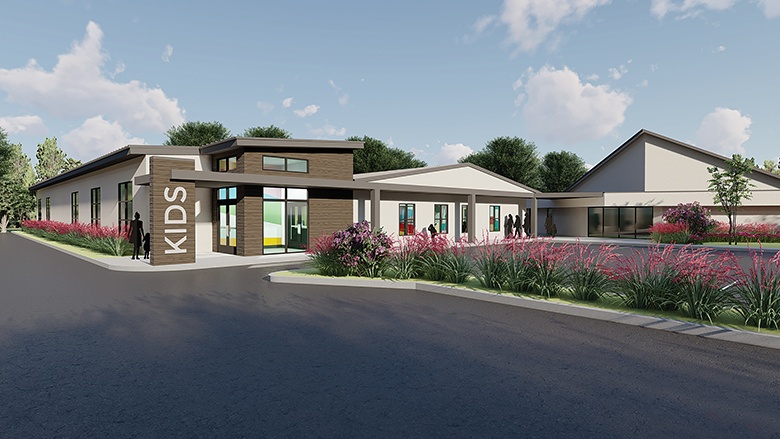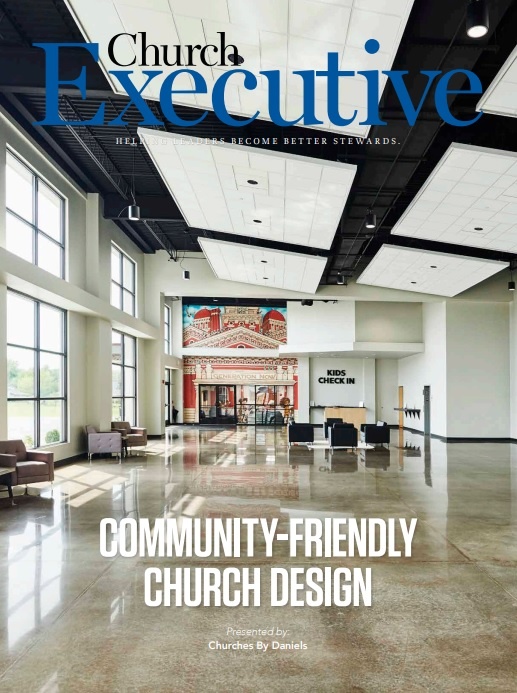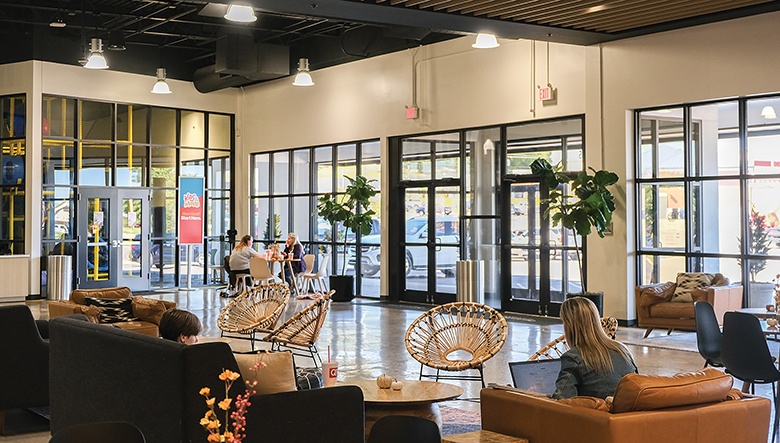In church design circles, we’re hearing the term “community-friendly” more and more often.
But why are churches, uniquely, in the thick of this movement?
And what does this community-friendly church design even look like?
By RaeAnn Slaybaugh

Leaders at BattleCreek Church consulted with the Churches by Daniels team on a design that prioritized community engagement. Prior to its renovation in [year], the kids’ facility was in a separate building. “It was hard for parents to tell where their kids should go,” explains Director of Marketing and Public Relations Alaina Butler. To rectify the issue, a covered walkway was added connecting the main church building and the children’s facility. “Just that extra step communicated to parents, ‘Hey, we don’t want you to have to take your baby out in the pouring rain to go to nursery or preschool,’ and, ‘We want you to just roll up to the parking lot and see the kids’ building right away.’
For Alaina Butler, director of marketing and public relations for Broken Arrow, Okla.-based Churches By Daniels, the answer to the first question is simple.
“The heart of the Church is to serve — not just their congregations, but also their outlying communities. It’s ‘people first,’ right?” she says. “I think that’s why we see a lot of churches being more open to the idea of community-friendly design, and also more physically open with their spaces.”
It couldn’t come at a better time: as Butler points out, social media and the internet inherently create separation and isolation.
“We’re seeing record numbers of mental health issues, of teen suicides. Despite all this connectivity, a lot of times, people feel like they’re actually alone,” she explains. “The door is open for the Church to invite people in, to ask them to come inside and be part of something.”
The impetus couldn’t be clearer. Now, let’s get into the nuts-and-bolts of community-friendly church design.
ELEMENT #1: Warm + welcoming
Conventional wisdom dictates that we all have just seconds to make a first impression. This is true of church design, also.
“If we want to impact our communities — and to communicate that we care about them — then it has to start visually,” Butler points out.
Translated, this means providing a warm, welcoming space. Providing “pockets” of seating in the lobby area is one simple way to do it.

“From the foyer and the fellowship hall, we’ve really upgraded to providing people with warm, almost living room-type environments,” Butler continues. “People need relationships. Churches can fulfill that need in the world by creating spaces where those relationships can be forged.”
Churches By Daniels Project Manager Luke DeNeui agrees.
“It used to be common to have some sort of a lobby or foyer, and then a fellowship hall, and that was it,” he points out. “Now we’re thinking about space a little bit differently. We’re thinking in terms of how we can create connection spaces for before and after worship services.”

“We see it pretty regularly now in churches — two or three spaces with a sofa, a few chairs, maybe an end table or two,” Butler adds. “This gives people spaces where they feel comfortable sitting down and having a conversation, not just feeling like they’re wandering around or sitting by themselves.”
And, as DeNeui points out, these same spaces are great options for Mother’s Day Out programs, homeschool activities, and many other small group gatherings.
“Having spaces that can be used by the church and by the community gets more people through the church doors,” he explains. “Really, as church builders, we’re providing many more flexible spaces than we used to.”
Doing so doesn’t have to come with a big price tag, either; it might simply mean rearranging the furniture.
“Churches should just take a really critical look at their spaces,” Butler suggests. “They can take the pieces they already have or spend a little extra money to make them visually pleasing — adding some lamps instead of fluorescent lighting, for example.”
ELEMENT #2: Accessibility + easy navigation
Americans with Disabilities Act [ADA] compliance is also important since it speaks to the independence which people with mobility and hearing challenges crave in a new space.
“Yes, things like handrails and wheelchair ramps are part of zoning, but churches should take a really intentional look at their facilities,” Butler advises. “That means asking ourselves, how easily can our spaces be navigated by somebody with a hearing or mobility challenge? Whatever accommodation for these individuals might look like in this context, prioritizing accessibility is a really great way to communicate that your church cares about its community.”
To be truly welcoming also requires easy navigation, starting in the parking lot. “People won’t wait around for a parking space,” Butler cautions.
In this respect, once inside, wayfinding should also be a priority.
“A first-time guest would prefer not to have to ask somebody where the restrooms are, or where the kids’ space is located,” she adds.
ELEMENT #3: Kid-friendly + mom-centric
Offering “kid-friendly, mother-approved” spaces at church isn’t a new concept. Obviously, if a child is excited to come to church, so are his or her parents. What is new(er) is making these areas available — to the community-at-large, not just church members or childcare customers — seven days a week.
To this end, lobbies with indoor playgrounds and coffee shops are a great combination. During the week, mothers with small children can get out of the weather and let their kids run around, for free, while they enjoy a latte. Church On the Move [Below] is a great example of this approach.
COTM has not only partnered with a local coffee shop that rents the café space in the lobby, but it also offers an afterschool program.

The large gathering area at Church on the Move [COTM] is, according to Butler, “a prime example” of community-friendly design. “’Pockets’ of seating invite more intimate conversation on a busy Sunday morning or even during the week,” she explains. Additionally, a well-known local coffee shop rents a café space at the church that is open seven days a week.
As detailed in a prior cover story, COTM repurposed a former gym in a shopping center for church use. Since the beginning, church leaders have been highly intentional and strategic about being part of the community, not just in it.
“Making the most of their high-visibility location on a busy corner, the church is ensuring that the whole community — even people that don’t go to church there — are able to get some value from the church’s presence,” Butler points out.
“Older children whose parents are still at work can go to the church and be safe, which is really cool,” Butler explains. “They have a safe space where they can hang out, do homework, or play on their phones until their parents get off work.”
Another church project, which is underway, includes all these elements — a large lobby, indoor playground, and coffee shop — as well as a commercial kitchen, according to DeNeui.
“We’re adding 15,000 square feet of space at the church to accommodate it all,” he says. “And because it’s new and separated from the rest of the building, they can lease it out for all kinds of community activities, and also for weddings.”
ELEMENT #4: Great outdoors
Many churches treat their outdoor spaces as secondary, but this square footage can be transformed into in-demand community gathering places by adding an outdoor amphitheater, a baseball diamond, a volleyball court, and so on.
“It’s important not to neglect the youth or student ministries when you’re thinking about this space,” Butler urges. “Any time you can get [young members] outside, it’s a great thing. Playing sports together, in particular, is a bonding experience both within the church and within the community.”
(“Don’t be afraid to ‘kick ‘em outside,’” she urges, laughing. “They’re tougher than the rest of us.”)
Even if the budget is tight, maximizing outdoor space is still an option just by adding some tables and chairs.
“Community is belonging in action”
Butler is reminded of this sentiment every time she goes to her gym, printed on a wall sign. But for her, it applies to community-friendly church design, as well.
“I think about this a lot from a faith-based perspective, where ‘belonging in action’ is where we find community,” she explains. “The more things a church does to create opportunities for people to just be together, to do things together — to live life together — that’s what builds a community. And it’s not just within a church; it’s within a city, too.”


